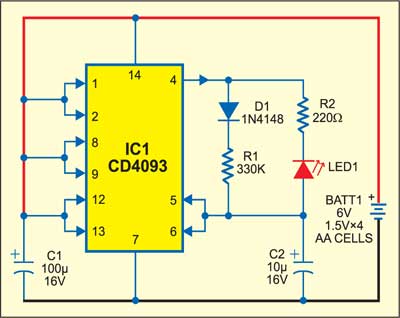 With this micro-power flasher you can baffle the intruders trying to break into your home. The unit continuously emits flashing light both during day and night giving the impression that the occupants of the house are present inside. The circuit can run off four 1.5V AA-size cells continuously for a long period.
With this micro-power flasher you can baffle the intruders trying to break into your home. The unit continuously emits flashing light both during day and night giving the impression that the occupants of the house are present inside. The circuit can run off four 1.5V AA-size cells continuously for a long period.
The human eye and brain sharply react to sudden changes in the light intensity, especially the flashing light. A flashlight for a minimum of 10 ms is necessary for perception at full brightness. The ability of the brain or retina called ‘persistence of vision’ keeps the memory of the vision for a period of 20 ms and then it slowly fades. The human eye can detect the flashing light as individual flashes only if the gap between flashes is greater than 20 ms. It is particularly attracted by a flashing light having a repetition period of 0.5 to 5 seconds.
Here a low-power CMOS IC CD4093 is used to generate sharp flashes from an ultra-bright red LED. CD4093 is a quad NAND gate IC and only one gate is used here as an oscillator. All the unused inputs are kept at logic ‘1’ by tying them to the positive rail to prevent floating and consequent damage due to statics.

LED1 is connected such that it receives the current from storage capacitor C2. This helps to reduce the battery drain since LED1 is not directly powered from the output of the IC.
The value of resistor R1 determines the current drain from the battery to charge capacitor C2. With the given value of 330 kilo-ohms, the current drain will be around 18 µA. (V/R=6/330,000 ohms=18 µA). Resistor R2 limits the current through LED1.
Typically, a 1.5V AA cell rated at 1.6 Ah has a nominal shelf life of five years. A low-leakage, good-quality battery can power the flasher for nearly three years.
The circuit costs less and can be constructed on a small perforated board. Enclose it in a small case with a front panel similar to that of a burglar alarm so that flashing LED1 gives the appearance of the alarm-‘on’ indicator. Use a high-brightness, transparent LED1 for eye-catching appearance.
The flasher can also be used as a pathfinder in corridors or exit doors when power fails or as a keyhole finder.









Unfortunately it does not draw 18uA, but more like 200 or 300uA on average. Source: I actually measured it, and it ruined my day.
CMOS gates draw almost no power when in logic 0 or 1 states, but when the input voltage slowly ramps up and down across the threshold as C2 repeatedly charges and discharges, the gate will draw significant current (up to almost 1mA). I learned this the hard way.
The total current depends on the tolerences and types of components including resistor, LED and supply voltage. There are low current ultra/super LEDs available in the market. Also refer CD4093 reference design articles.